Research / Annual reports / Main research results of the Institute for Condensed Matter Physics of NAS of Ukraine in 2022
Main research results of the Institute for Condensed Matter Physics of NAS of Ukraine in 2022
A problem of exact description of dynamic processes in liquid state, connected with existing relaxation processes on different time scales, requires simplified models for understanding the features of acoustic modes in complex liquids. An unstable elasticity model with fluctuating elastic moduli was proposed for description vibrational and relaxing modes. Based on an approach of instantaneous normal modes (INM) and on the proposed unstable elasticity model the low-frequency asymptotes for the density of states of vibrational and relaxing modes were obtained. The obtained theoretical results allow nicely recover the simulation data for density of vibrational states (W. Schirmacher, T. Bryk, G. Ruocco, PNAS, 119, No. 8, e2119288119 (2022), https://doi.org/10.1073/pnas.2119288119).

(A) INM spectra for different temperatures as indicated in the legend. The eigenvalues and temperatures are in LJ units. (B) INM spectra of our unstable elasticity model, calculated in SCBA (self-consistent Born approximation) disorder parameters, assuming γ(T)=T/0.24 for the same values of T as for (A).
A theoretical analysis of charge storage in electrochemical capacitors with electrodes based on carbon nanotubes (CNT) has been performed. Contrary to the traditional view, the low quantum capacitance of nanoporous electrodes can enhance energy storage by shifting the charging to higher voltages. We focused on narrow CNTs because of the available analytical solutions, allowing systematic and reliable analysis of the electrode charging under a wide range of applied voltages. However, similar principles can apply to other nanoporous electrodes. Thus, our results suggest, quite generally, “spoiling” a high-quantum capacitance electrode to enhance its energy storage at increased voltages, at which the electrical double-layer capacitance is low or vanishes (T. Verkholyak, A. Kuzmak, A.A. Kornyshev, S. Kondrat, J. Phys. Chem. Lett., 13, 47, 10976–10980 (2022), https://doi.org/10.1021/acs.jpclett.2c02968).


Certain soft matter systems characterized by so called competing interactions between particles are known to form various patterns at the micro or mesoscale that can be significantly modified by confinement. Controlling such patterns could aid in designing materials with desired properties, for example for energy storage. We have proposed a model of competing pair interaction in the form of a three-Yukawa (3Y) potential. The results of computer simulations show that the model proposed can indeed describe spontaneous appearance in a homogeneous fluid of a large variety of mesostructured phases. Furthermore, these self-assembly effects appear to be favored by the presence of confining walls. A field theory approach has been applied to a mesoscopically homogeneous 3Y fluid at a hard wall. Explicit analytical expressions for the structural properties, namely the pair correlation function and the density profile, have been derived. The structure factor has been calculated by introducing an effective temperature-dependent hard core radius characteristic of the system. The role of this temperature dependence in the reentrant nature of phase behavior has been discussed. The theoretical results obtained are in good agreement with computer simulations data (I. Kravtsiv, T. Patsahan, M. Holovko, D. di Caprio, J. Mol. Liq., 362, 119652 (2022), https://doi.org/10.1016/j.molliq.2022.119652).

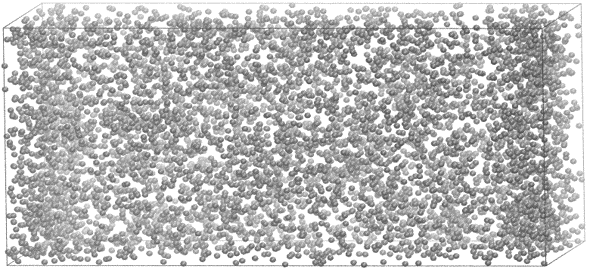
Molecular docking is one of the cornerstone tasks for the description of interactions of proteins with small organic molecules in many biological systems. We suggest a combined computational approach to protein-ligand binding. The approach consists of two steps: (1) a deep neural network is used to locate a binding region on a target protein, and (2) molecular docking of a ligand is performed within the specified region to obtain the best pose using Autodock Vina. Our in-house designed neural network was trained using the PepBDB dataset. Although the training dataset consisted of protein-peptide complexes, we show that the approach is not limited to peptides, but also works remarkably well for a large class of non-peptide ligands. The results are compared with those in which the binding region (first step) was provided by Accluster. In cases where no prior experimental data on the binding region are available, our deep neural network provides a fast and effective alternative to classical software for its localization (M. Simončič, M. Lukšič, M. Druchok, J. Mol. Liq., 353, 118759 (2022), https://doi.org/10.1016/j.molliq.2022.118759).
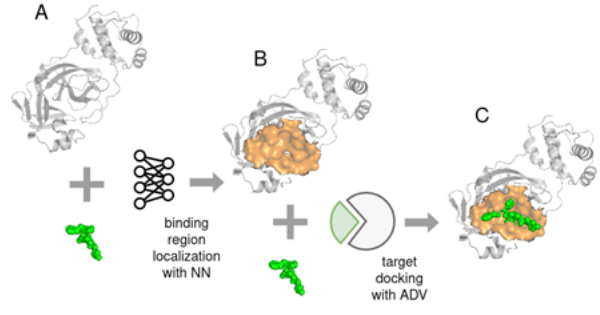
The model antibody fluid in random hard sphere porous media mimicking system of antibodies in crowded cell environment is proposed. One of the aspects that may take place in such a system, in particular the attractive interaction between antibody molecules and the porous medium, has been studied. The influence of such an attractive interaction on the phase behavior of the model, percolation, cluster size distributions of proteins and the second virial coefficient of the model was studied. An important achievement of this research is that a new mechanism of the re-entrant phase behavior of such an associating system has been obtained. The reason for such re-entrant phase coexistence, when the same fluid density occurs at two different temperatures, is the attractive interaction between the fluid and the porous medium. Due to the protein-obstacle interaction, a layer of mutually bonded antibodies around the obstacles is formed and the corresponding network becomes strongly nonuniform, with the local distribution of antibodies centered on the obstacles. In other words, the distribution of the colloid particles in the network is governed by the distribution of the obstacles. Features described in this study may open possibilities to produce equilibrium gels with predefined nonuniform distribution of particles and indicate how complicated the phase behavior of biological macromolecules in a crowded cellular environment may be (T. Hvozd, Yu. Kalyuzhnyi, V. Vlachy, Soft Matter, 18, 9108–9117 (2022), https://doi.org/10.1039/D2SM01258H; T.V. Hvozd, Yu.V. Kalyuzhnyi, V. Vlachy, P.T. Cummings, J. Chem. Phys., 156, 161102 (2022), https://doi.org/10.1063/5.0088716).
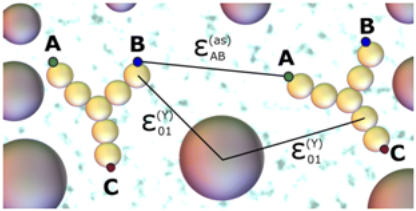
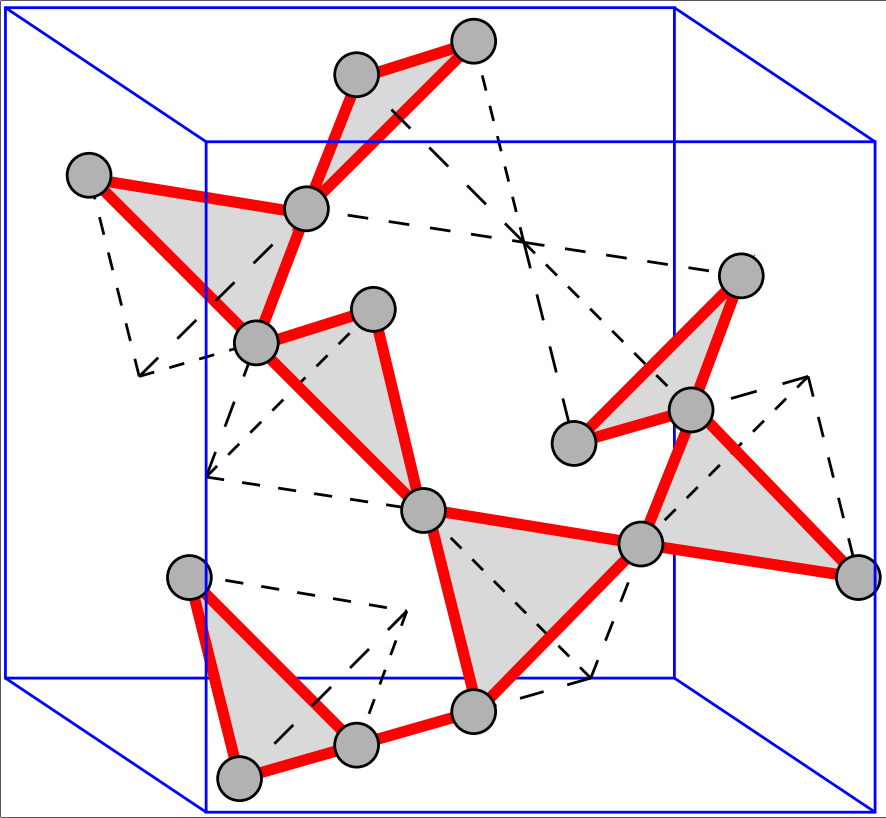
Geometrically frustrated hyperkagome lattice is a three-dimensional network of corner-sharing triangles. Ground states of the classical Heisenberg model are highly degenerate, although a weak nematic order emerges at low temperatures. This is an indication of the possible arising of a plethora of exotic quantum phases. Moreover, there are several experimental compounds where localized magnetic moment forming hyperkagome lattice and magnetic order do not appear even at low temperatures. Na4Ir3O8 and PbCuTe2O6 are two of the most experimentally studied compounds. Despite considerable interest in S=1/2 Heisenberg antiferromagnet on hyperkagome lattice, theoretical predictions for the ground state and finite temperature properties are scarce. We use the so-called entropy method to interpolate between low and high temperatures using high-temperature expansion of the 16th order. This approach implies sum rules for the energy and entropy and allows us to get reliable results on the whole temperature range. We also gave an estimate for the ground state energy (T. Hutak, T. Krokhmalskii, O. Derzhko, J. Richter, Eur. Phys. J. B, 95, No. 6, 93 (2022), https://doi.org/10.1140/epjb/s10051-022-00359-0).
The scaling behavior of the density and correlation function of target particles in a medium containing diffusive traps that can coagulate or mutually annihilate was studied using the field-theoretic renormalization group (RG) method, and the diffusion of particles is modeled by Lévy flights — random walks in which the step length is described probability distribution with a “fat tail”. In the RG approach, it is shown that for space dimensions below the upper critical one d ≤ dC = σ, where the parameter σ controls the form of the Lévy distribution, the target particles density is characterized by a universal exponent, and the density-density correlation function is characterized by an additional exponent. It was established that, at least in the one-loop approximation, these exponents are related to similar expressions for the ordinary diffusion case, when the space dimension is replaced by the effective one. The obtained analytical results for the density decay exponent were confirmed by the numerical simulations for d =1 (D. Shapoval, V. Blavatska, M. Dudka, J. Phys. A: Math. Theor., 55, 455002 (2022), https://doi.org/10.1088/1751-8121/ac9c39).
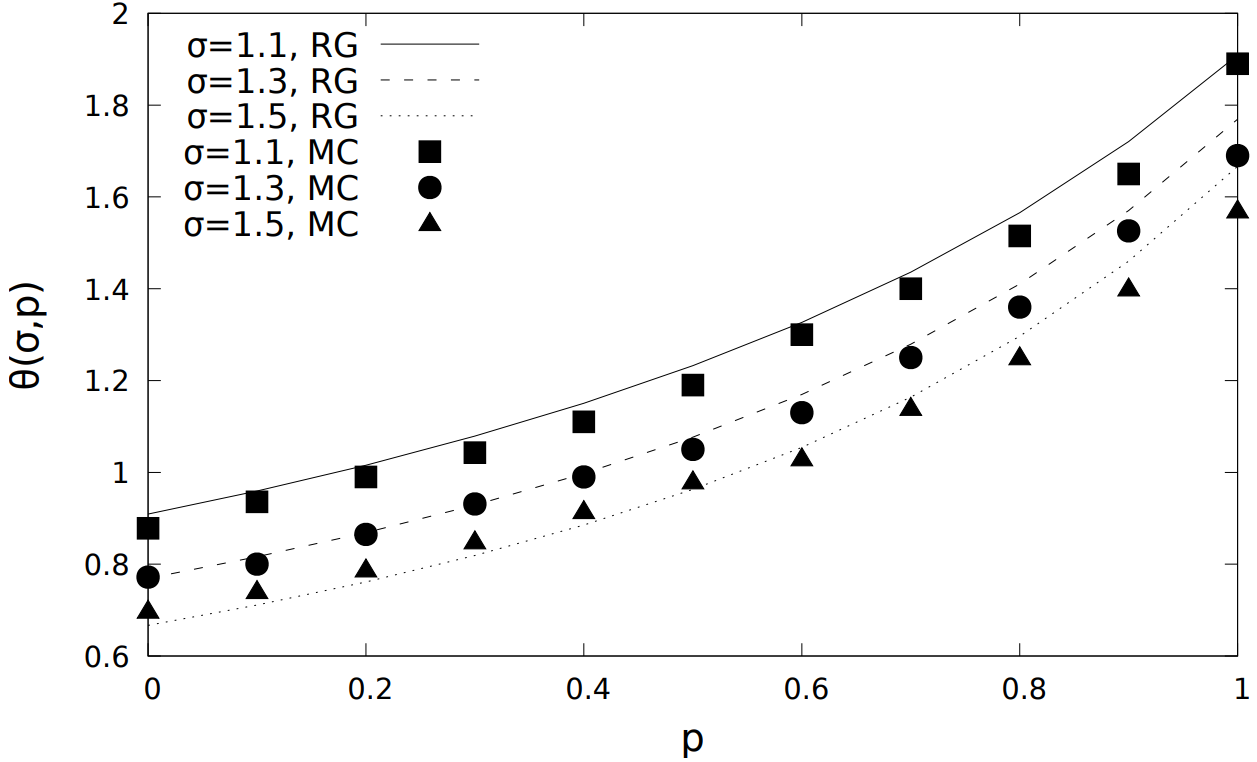
Target particles density decay exponent θ as a function of coagulation/annihilation probability for equal diffusion constants and various values of the control parameter of the Lévy distribution σ. The lines show the analytical predictions, while the symbols show the results of the computer simulations.
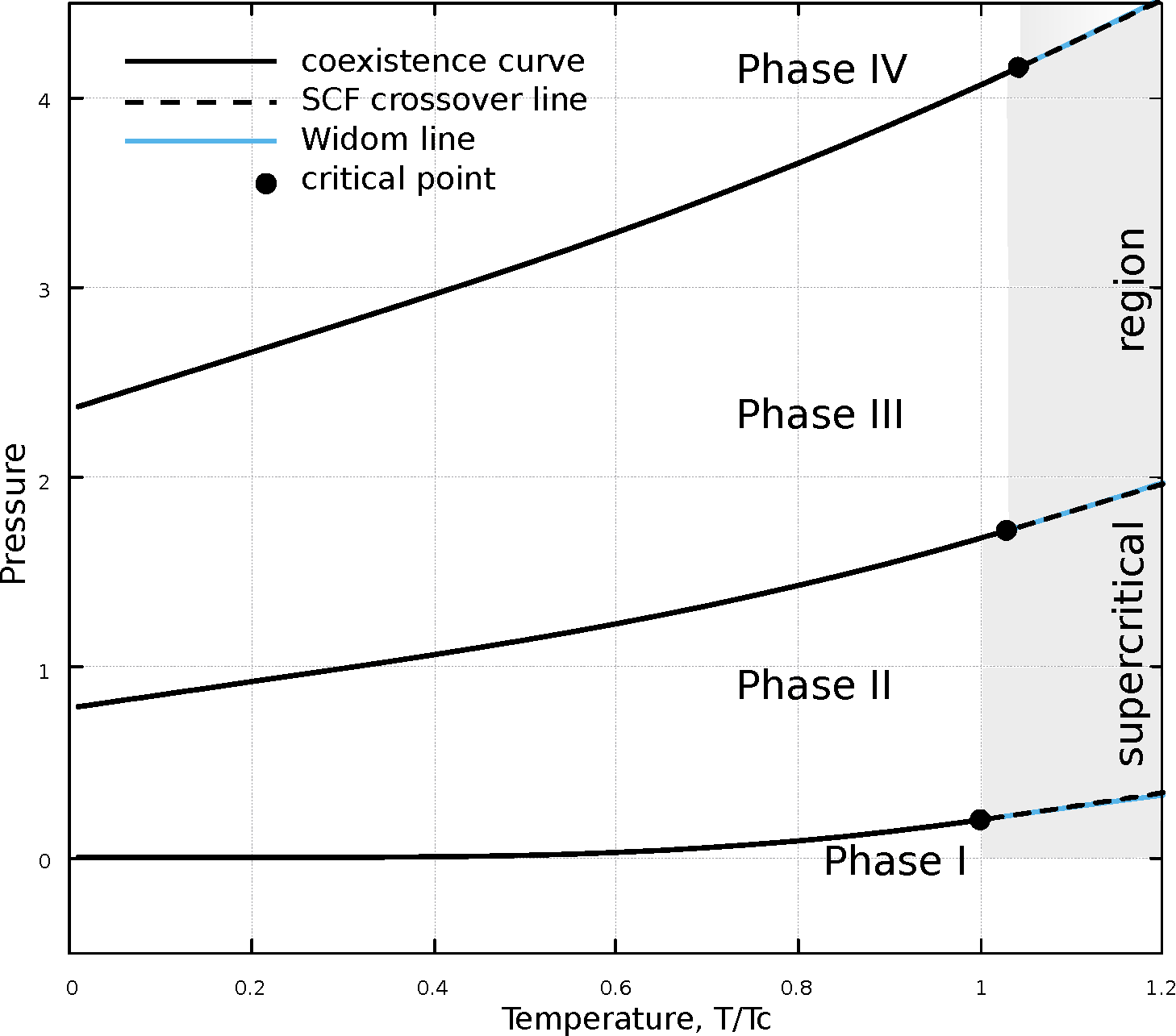
Phase diagram.
The object of the research is the model of a continuous system of particles with Curie-Weiss interaction. The chosen form of the interaction potential determines the division of the space in which the particles are into Nv cubic cells of the same size. Particles repel each other with intensity gr if they reside in the same cell and attract each other with intensity ga/Nv regardless of their position. We obtained the exact equation of state of such a model in the grand canonical ensemble formalism and also established for it the presence of a sequence of the first-order phase transitions at temperatures below the critical Tc. Due to the increasing interest of application in technology, the search for ways of determining the line between gaseous and liquid structures of supercritical fluids (SCF) is gaining relevance. This line is extension of the coexistence curve in the supercritical region (above the critical point). The most common is the method to calculate the Widom line, that is, the line of maxima, in particular, of compressibility and heat capacity. In the supercritical region, the pressure of our model is a monotonuously increasing function of temperature and density. However, we saw a sharp increase in the values, the so-called peaks, of the isothermal compressibility and isobaric heat capacity as the critical point is approached. We proposed a method of obtaining the crossover lines between structures of the supercritical fluid based on the equation of state and analysis of the behaviour of the chemical potential of the system. In the temperature range Tc
A large-scale quantitative analysis of Ukrainian economic research is performed using publication data. This is one of the first examples of multidimensional and longitudinal disciplinary analysis at the national level based on Crossref data. Different aspects of Ukrainian economic discipline output are studied here. In particular, the collaborative nature, geographic landscape, some peculiarities of citation statistics, gender effects and authors’ names ordering are investigated. To this end, special methods of working with bibliographic data with a predominant share of non-English authors are used. Based on our analysis, we discuss specific and universal features of Ukrainian economic research (O. Mryglod, S. Nazarovets, S. Kozmenko, J. Data Inf. Sci., 8, No. 1, 1–18 (2022), https://doi.org/10.2478/jdis-2023-0001).
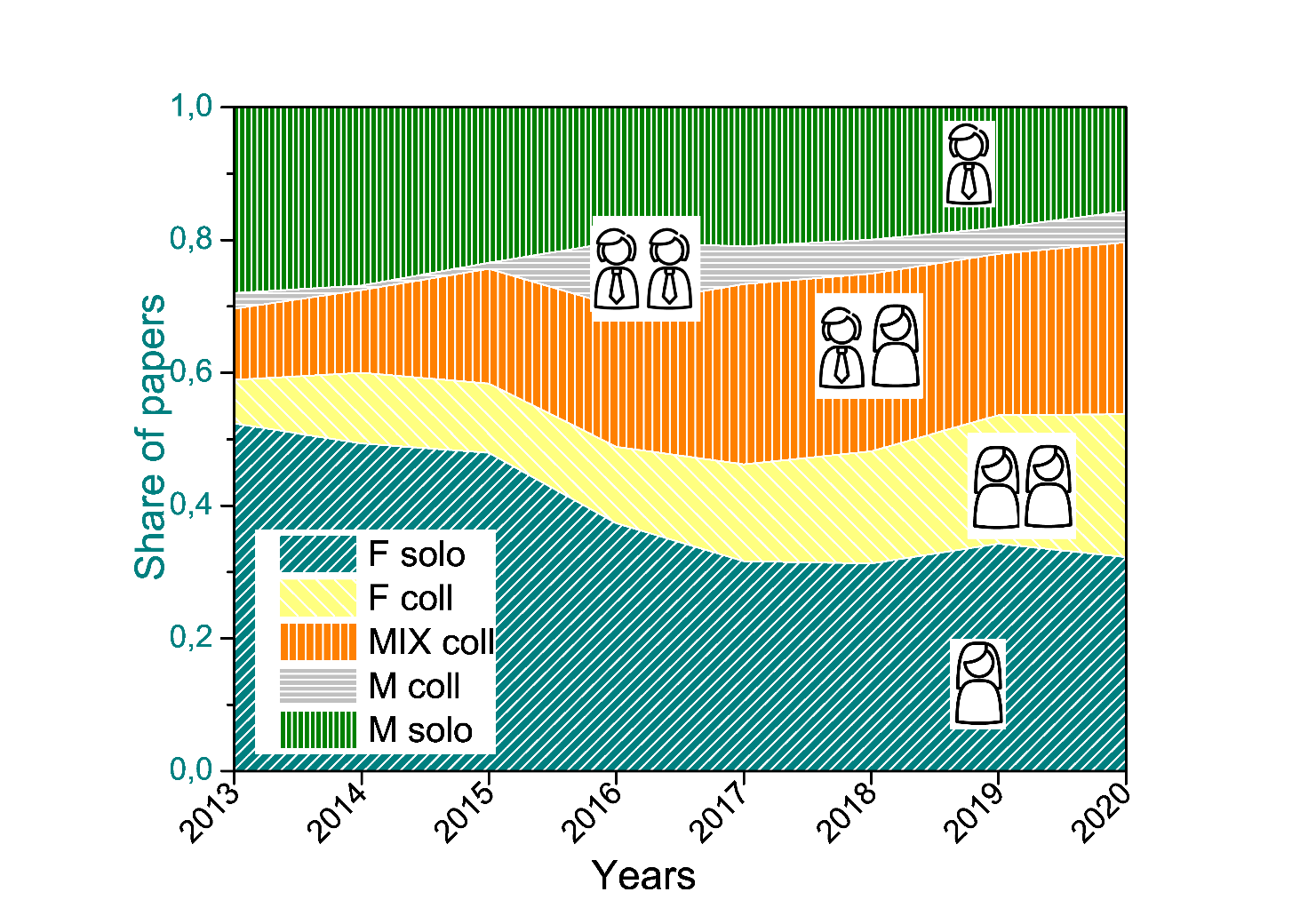
Annual dynamics of shares of papers classi ed according to the gender of authors: a single female author (F solo); two or more authors, only females (F coll); two or more authors, at least one female and at least one male (MIX coll); two or more authors, only males (M coll); a single male author (M solo). The time window between 2013 and 2020 is chosen for visualization due to small annual statistics (less than 100 papers per year) before 2013.